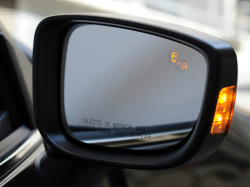
— Would you pay $600 for three safety features with the potential of stopping 10,000 fatal crashes a year?
According to a study from Carnegie Mellon University, the three features have the potential to stop or decrease the severity of 1.3 million crashes per year, including 133,000 that result in occupant injuries and 10,000 fatalities.
While automakers rush to develop autonomous vehicles that will take all driving duties from humans, Carnegie Mellon researchers say manufacturers shouldn't wait to equip cars with safety features that are known to save lives.
Researchers say blind spot monitoring, lane departure warning and forward collision warning systems can be very effective in reducing nearly a quarter of U.S. vehicle collisions every year. The study used 2012 accident data compiled by the National Highway Traffic Safety Administration during a time when 31,006 people died in car crashes.
Although these technologies are included in driverless cars, those cars have a long way to go before consumers can sit back and let the cars do all the driving. And when a crash occurs using technology to assist a driver, such as in a Tesla Model S fatality, progress will hit a speed bump for full driverless cars.
However, researchers say none of this should stop widespread deployment of the features they studied, especially when the price is only $600 extra per car.
In the study, researchers arrived at an estimation of $600 per car for all three features by using Toyota vehicles during the 12-month study. Even a so-called economy car such as the 2016 Honda Civic has the three safety features, plus adaptive cruise control and cross-traffic monitoring.
Carnegie Mellon researchers determined if blind spot monitoring, lane departure warning and forward collision warning systems were equipped in every vehicle on the roads, the drastic decline in crashes would save anywhere from $18 billion to as much as $202 billion per year.
Those are some impressive numbers for a $600 investment in three technologies.
Researchers say these technologies are needed because driving skills are lacking and drivers overstate their abilities when in reality drivers have trouble using simple turn signals. Add to that the rampant and dangerous distractions of wireless technology that keeps drivers talking on cellular networks around the clock.




